Effective Feedback
> Sarahbonnell
> Action Research 2017/18
Year 10 Formative Assessment Air Time. Whole class feedback Language Paper 1. Whole class verbal feedback. Educational Endowment Foundation Marking Review April 2016. Giving effective student feedback. Effective student feedback is increasingly being recognised as a key influence on learning and student achievement.
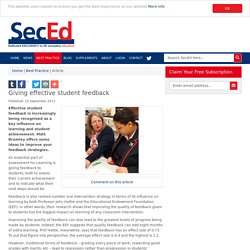
Matt Bromley offers some ideas to improve your feedback strategies. An essential part of Assessment for Learning is giving feedback to students, both to assess their current achievement and to indicate what their next steps should be.
Seven ways to give better feedback to your students. Feedback can be a difficult business.
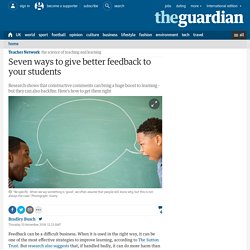
When it is used in the right way, it can be one of the most effective strategies to improve learning, according to The Sutton Trust. But research also suggests that, if handled badly, it can do more harm than good.
Toolkit Strand. Feedback is information given to the learner and/or the teacher about the learner’s performance relative to learning goals.
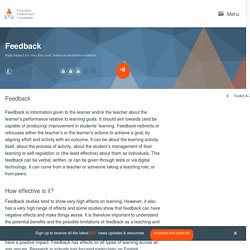
It should aim towards (and be capable of producing) improvement in students’ learning. Feedback redirects or refocuses either the teacher’s or the learner’s actions to achieve a goal, by aligning effort and activity with an outcome. It can be about the learning activity itself, about the process of activity, about the student’s management of their learning or self-regulation or (the least effective) about them as individuals. This feedback can be verbal, written, or can be given through tests or via digital technology. It can come from a teacher or someone taking a teaching role, or from peers.
The Behaviour Guru: Tom Bennett's School Report: It's your time you're wasting; why schools should stop drowning teachers in marking. One does not simply walk into Mordor, and one does not simply pop into IKEA for a packet of napkins and an Ottoman.
The Scandinavian elves play a voodoo on your flimsy aspirations of frugality, and by the time you're supping on a hot dog in the car park of Valhalla you're dragging a caravan of Billy bookcases, tea candles, picture frames and a rug that doubles as a shoe tidy. And you forgot the Ottoman. We've all done it; started out with one plan and ended up with another. That's fine when Plan B is also something you want (cf: Professor Mickey Flanagan's seminal 'Out/ OUT-out theory of organic incremental decision decay' for details). But not if you put your hand in your pocket for a Swiss knife and pull out a Swiss roll.
I was reminded of this recently when I heard of a colleague's experience in a struggling school in the Midlands. But what? At a previous school I taught humanities to 10 or 11 classes of approximately 25 kids apiece. Not waving, but marking Enough.
Teachers 'wasting time on marking in coloured pens'
Image copyright Thinkstock Teachers are spending too much time over-marking pupils' homework, Schools Standards Minister Nick Gibb has said.

He told MPs that marking in different-coloured pens, and giving feedback in exercise books, had never been a government or an Ofsted requirement. He told the Education Committee that the practice was adding to teachers' workload - one of the top reasons given by them for leaving the profession. Instead, work should be marked with a simple grade, he suggested. Mr Gibb was responding to questions on how teacher workload was affecting recruitment and retention of teachers.
A recent report found many teachers working as many as 60 hours a week. He said teachers in England worked longer hours than the OECD average, but spent the same amount of time in front of a class.
Marking & workload; pages 5-10 are the most useful.
Reducing Teacher Workload By Re-Thinking Marking-The Michaela Files, Part 1. Last week i visited London’s faintly notorious Michaela School.
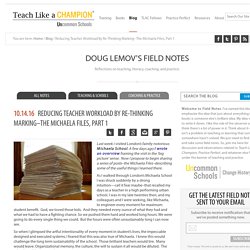
A few days ago I wrote an overview framing the visit in the ‘big picture’ sense. Now I propose to begin sharing a series of posts–the Michaela Files–describing some of the useful things I learned there.
Teacher: 'How I minimised marking and reclaimed my weekend'
Stand in a school staff car park on a Friday afternoon, watch the teachers leave and count the number of them who emerge blinking into the sunlight burdened by piles of books.
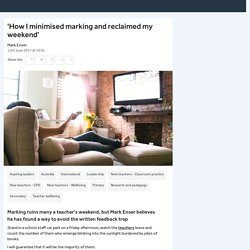
I will guarantee that it will be the majority of them. Some stuff the books into a bag for life, others in boxes. I have even known some teachers to buy special carts on wheels in order to get their teetering piles of marking to the car. Some of these books will never get further than the hall, where they will sit all weekend in silent reproach and cast a shadow over any attempt to relax. Others will be hastily marked on a Sunday morning, while the kids are busy, or will drag out and dominate the whole weekend.
Effective Marking. We're all about helping teachers with high quality teaching materials, but hand in hand with that goes the time saving element.
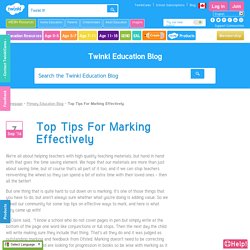
We hope that our materials are more than just about saving time, but of course that's all part of it too, and if we can stop teachers reinventing the wheel so they can spend a bit of extra time with their loved ones - then all the better! But one thing that is quite hard to cut down on is marking. It's one of those things that you have to do, but aren't always sure whether what you're doing is adding value. So we asked our community for some top tips on effective ways to mark, and here is what they came up with! 1. 2. 3.
We think students deserve better exercise books! Introducing exercise book 1.0 - a traditional lined book, doodled!
Improving Written Feedback. This week I gave a seminar at TeachMeet Clevedon.
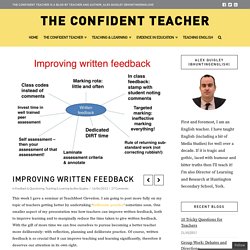
I am going to post more fully on my topic of teachers getting better by undertaking ‘deliberate practice‘ sometime soon. One smaller aspect of my presentation was how teachers can improve written feedback, both to improve learning and to marginally reduce the time taken to give written feedback. With the gift of more time we can free ourselves to pursue becoming a better teacher more deliberately: with reflection, planning and deliberate practice.
Marking and written feedback in science.
Feedback sits at the top of Professor John Hattie’s table of effect sizes on education performance.
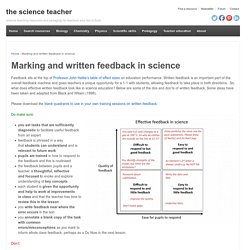
Written feedback is an important part of the overall feedback machine and gives teachers a unique opportunity for a 1-1 with students, allowing feedback to take place in both directions. So, what does effective written feedback look like in science education?
Diagnostic Questions. Diagnostic Questions are a quick and accurate way of assessing your students’ knowledge and understanding of a key skill or concept, identifying fundamental misconceptions that they may have.

In short, they provide meaningful Assessment for Learning (AfL). Colleagues writing diagnostic questions together can also benefit significantly in developing their understanding of how students learn a particular topic, aiding their planning and delivery of lessons. In addition, students‘ understanding of a topic and their higher order thinking skills can be pushed to the limit by challenging them to create their own Diagnostic Questions. We can best illustrate the key concepts behind Diagnostic Questions with a simple example. One of the answers is correct, and three are incorrect.
Written feedback. 12 Ways to Embrace Marking and Feedback by @TeacherToolkit. Reading Time: 3 minutes.
There are a few days left before the end of term and this is one last marking and feedback blog before the summer holidays begin. What feedback techniques could you use that make students think and take action? Marking has two purposes. One, students act on feedback and make progress over time. Two, it informs future planning and teaching.
5 Research-Based Tips for Providing Students with Meaningful Feedback. In recent years, research has confirmed what most teachers already knew: Providing students with meaningful feedback can greatly enhance their learning and achievement. Professor James Pennebaker from the University of Texas at Austin has been researching the benefits of frequent testing and the feedback it leads to.
He explains that in the history of the study of learning, the role of feedback has always been central: “When people are trying to learn new skills, they must get some information that tells them whether or not they are doing the right thing. Learning in the classroom is no exception. Both the mastery of content and, more importantly, the mastery of how to think require trial-and-error learning.”
What-the-strategy-looks-like-quality-teacher-marking. Effective Marking. WHY BOTHER? Effective marking allows us as teachers to show the children that we teach that we value their efforts. It allows us to judge our own effectiveness as teachers. It is when we can make strategic decisions about the next steps children need to make.
But more importantly it is a rare opportunity to have an individual dialogue with every child. Without it most of the children we teach would never get that one to one feedback they need in order to make outstanding progress.
Stretch and Challenge. Stop writing feedback comments…..and see what happens!
We are constantly trying out new ideas to ease workload and marking/feedback is always one area that my colleagues are keen to swop and share ideas on. I know that others have the same concerns and that our huge blogs of shared practice are by far the most read, borrowed from and commented upon that we have published externally.
Confessions of a primary headteacher: The new no marking policy in my school and how it works. The Key to Effective Marking in Schools. What-the-strategy-looks-like-quality-student-marking. Empowering Students to lead the feedback process (SWH Dissertation)
Marking in Perspective: Selective, Formative, Effective, Reflective. Marking in Perspective: Selective, Formative, Effective, Reflective.
GUEST POST: Is Your Feedback Carefully Used, or Barely Perused? — The Learning Scientists. Verbal feedback: Telling ’em what they need to do. Marking is not the same as feedback by Toby French. So, how might we best feed back? by Toby French. 20 Ways To Provide Effective Feedback For Learning. Live Feedback in Lessons. The teacher who gave up marking – and believes you can, too. Teachers can give up marking without any detrimental effect on students, according to an English teacher who has done just that. In fact, he says students are better off if teachers ditch the ticks, coloured pens and stock feedback phrases.
Why marking students’ books should be the least of a language teacher’s priorities – The Language Gym. What-the-strategy-looks-like-verbal-feedback. Action Research Plan 2 - From Marking to Feedback. Measuring the IMPACT of Action Research. 25 Teaching Tools To Organize, Innovate, & Manage Your Classroom. Teachingenglish.org. Digitaltrends. Mrs. Brosseau's Binder: How Google Forms Saved This Teacher's Sanity.










